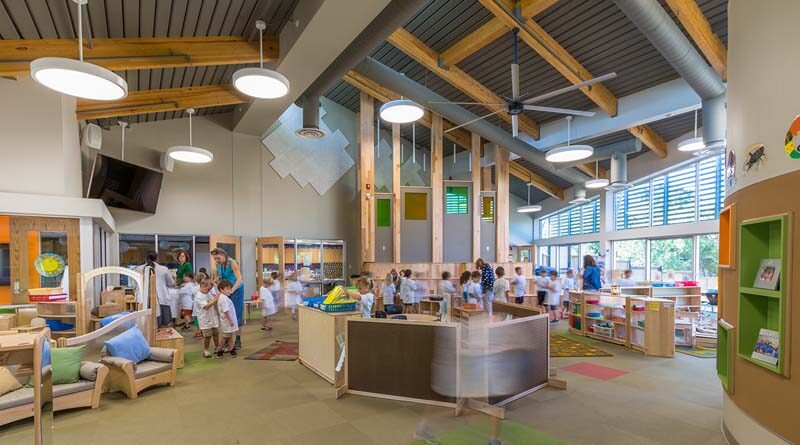Creating Thoughtful Environments for Early Learners
By Diego Barrera
As the global pandemic unrolled across the country, participation in early childhood programs dropped dramatically. Data from the National Institute for Early Education Research (NIEER) shows enrollment dropped by half. It is too early to understand the impact this pandemic will have on young learners, but research does show children who have access to high-quality Pre-K programs do better in school.
Early childhood education programs have the potential for setting a child on a path to long-term academic success. Access to early education is not enough. The environments we design for children play a major role in fulfilling that potential and realizing lifelong impacts in the lives of young learners.
Research shows that high quality early education benefits students. So, what makes a program “high quality?” How can the environment help achieve that standard? Let us explore how the environment can be a positive influence in student success.
NIEER provides benchmarks for high quality Pre-K that focus on teacher development, appropriate student-to-teacher ratios (1 teacher for every 10 students), and a rich curriculum that addresses the comprehensive Early Learning & Development Standards (ELDS). These standards concentrate on five domains:
- Physical well-being and motor development
- Social/emotional development
- Approaches to learning
- Language development
- Cognition and general knowledge
Research by the Brookings Institution supports this focus on curriculum, highlighting “a well implemented, evidence-based curriculum” as a key factor for effective Pre-K programs in its 2016 report.
There is a rich diversity in how early learners are educated — from programs that immerse students in nature, to programs that focus on social-emotional skills, to others that promote student-led exploration. There is also a trend towards providing young learners with spaces that promote positive interaction, greater access to the outdoors, and more opportunities to explore. Learning environment designs can enhance these opportunities and support a high-quality educational experience.
Choice and Voice
A successful learning environment encourages opportunities for learning in various ways, promotes health and wellness, and provides a wide range of possibilities for its users. Thoughtful building design can promote respect for learning and a sense of belonging, ownership, and pride for all members of the school community.
Community and student input helps our team create a welcoming place for learning. Young learners feel comfortable in these environments because they reflect their culture and provide choices for shaping their own spaces, sparking interaction and positive exchange. St. Andrew’s Kindergarten in Austin, Texas, is a great example of how the design team, working closely with the school community, created spaces that reflect school and community values. Within the design, flexible learning spaces allow students to customize their space for their individual needs. Display areas are also carefully planned to accommodate student work, further promoting a sense of pride and ownership.
Additionally, our design team created space for the community to gather and display. The breakout space by the entry can accommodate parent and community meetings and the large display wall has space for parents and community to use. Our design process focused on collaboration with stakeholders to develop a common vision and sense of community which shaped the design of St. Andrew’s Kindergarten.
The Great Outdoors
Learning outdoors, surrounded by nature, reduces stress, promotes activity, and helps students focus. The Springfield Literacy Center in Springfield, Pa., was designed with these ideas in mind. The outdoor space features plants and vegetation that provide tactile and sensory experiences for students – allowing them to explore, learn while they play, and connect with nature. Our design team was inspired by studies that show movement and physical activity assist students’ learning and retention, and used this inspiration to create the alphabet walk — which encourages students to practice their ABCs while engaging in a modified version of hopscotch.
The outdoors can also be brought indoors. For the Child Development and Learning Lab, designed as part of the College of Education and Human Services for Central Michigan University, our design team aimed for a strong indoor-outdoor connection. By incorporating tall windows looking into an outdoor Learning Garden, the design offers a high level of transparency and natural light to the interior spaces while providing a direct outside connection.
Curiosity and Exploration
Many Pre-K schools embrace the principle of a prepared environment to facilitate student exploration and independent learning. For the Early Learning Laboratory in Grand Rapids Community College, our goal was to design a space where students had the freedom to explore and have access to stored materials to use for creative projects. This freedom also engenders responsibility as students know to use the materials respectfully and return them to their location when finished. Also through this method, students shape their learning experience depending on their level of curiosity. A thoughtfully designed space promotes this curiosity in an organized and flexible environment. Through technology integration, the classroom design gives students access to devices when appropriate, while not making these the focus of the space.
Early childhood education propels students to succeed later in life, and a well-designed Pre-K facility offers a place for that learning to start. The quality of the spaces within a facility should respond to the needs of early learners and create a foundation for their path to fulfilling their learning potential.
Diego Barrera, AIA, NCARB, ALEP, LEED Green Associate, is a senior design architect with Stantec and has more than a decade of experience bringing architecture and education together to create student centric learning environments.

